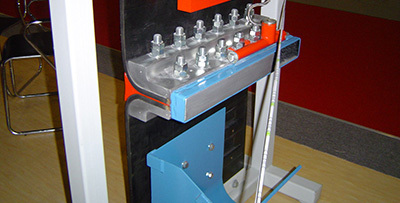News Center
Hezi technology focuses on the research and development of "rapid seamless conveyor belt joint sleeve" innovative technology project

NEWS CENTER

News Details
Understanding the Role of Belt Fasteners in Rubber Belt Applications
Release time:
2024-12-19
Explore the crucial role of belt fasteners in rubber belt applications. This in-depth article examines types, benefits, installation processes, and industry best practices, ensuring you have all the i
Understanding the Role of Belt Fasteners in Rubber Belt Applications
Table of Contents
- 1. Introduction to Rubber Belt Applications
- 2. The Importance of Belt Fasteners in Rubber Belts
- 3. Types of Belt Fasteners Used in Rubber Applications
- 4. Benefits of Using Belt Fasteners
- 5. Installation Process for Belt Fasteners
- 6. Maintenance Tips for Rubber Belts with Fasteners
- 7. Common Problems and Solutions in Belt Applications
- 8. Industry Best Practices for Belt Fasteners
- 9. Conclusion
- 10. FAQs
1. Introduction to Rubber Belt Applications
Rubber belts play a vital role in numerous industrial applications, serving as the backbone of conveyor systems, power transmission devices, and other machinery. They are designed to handle various materials, withstand harsh environments, and ensure reliable operation. To optimize performance, the use of **belt fasteners** becomes essential in ensuring that the rubber belts remain intact and functional throughout their lifespan. Understanding the various types and applications of belt fasteners can significantly enhance the reliability and efficiency of rubber belt systems.
2. The Importance of Belt Fasteners in Rubber Belts
Belt fasteners are critical components that connect the ends of rubber belts, facilitating seamless operation in various industrial settings. They contribute to the overall durability and functionality of the belt by:
- **Ensuring a Secure Connection**: Belt fasteners provide a robust link between the belt ends, preventing slippage and misalignment during operation.
- **Facilitating Maintenance and Replacement**: Fasteners allow for quick disassembly and reassembly of belts, enabling easier maintenance and timely replacements without extensive downtime.
- **Accommodating Different Lengths**: Fasteners enable the adjustment of belt lengths, accommodating changes in operational requirements or equipment arrangements.
Understanding and selecting the right type of fastener is crucial for maximizing the effectiveness of rubber belt applications.
3. Types of Belt Fasteners Used in Rubber Applications
There are several types of belt fasteners available in the market, each serving specific needs and applications. Choosing the right fastener type is essential for ensuring optimal performance and longevity of the rubber belt.
3.1 Mechanical Fasteners
Mechanical fasteners are one of the most commonly used fasteners in rubber belt applications. They typically consist of metal components that physically clamp the ends of the belt together. These fasteners are easy to install and adjust, making them a popular choice in various industries. Common types include:
- **Bolt-on Fasteners**: These are attached using bolts and nuts, providing a strong and secure connection.
- **Hinge Fasteners**: Hinge-style fasteners allow for easy belt replacement and maintenance, as they enable the belt to pivot and flex.
3.2 Vulcanized Fasteners
Vulcanized fasteners are integrated into the rubber belt during the manufacturing process. They involve chemically bonding the fastener into the belt material, creating a seamless connection that enhances durability. This type of fastener is ideal for high-stress applications where maximum strength is required.
3.3 Clamp Fasteners
Clamp fasteners are designed to hold the ends of the belt securely together without the need for drilling or additional components. They typically consist of a metal clamp that compresses the belt ends, ensuring a tight fit. Clamp fasteners are particularly suitable for applications that require frequent belt changes.
4. Benefits of Using Belt Fasteners
Utilizing belt fasteners in rubber belt applications offers numerous advantages, including:
- **Increased Reliability**: A secure connection between belt ends reduces the risk of breakage or slippage, enhancing overall system reliability.
- **Cost-Effectiveness**: The ability to quickly replace or adjust belts with fasteners minimizes downtime, leading to cost savings in operations.
- **Versatility**: Different types of fasteners can be chosen based on specific application needs, providing flexibility in operations.
- **Enhanced Performance**: Properly secured rubber belts perform more efficiently, delivering optimal results in material handling and transmission tasks.
5. Installation Process for Belt Fasteners
The installation of belt fasteners is a critical step that requires careful attention to detail. Here’s a step-by-step guide to ensure effective installation:
1. **Preparation**: Before installation, ensure the belt is clean and free from debris. Measure the belt to determine the correct length and alignment.
2. **Cutting the Ends**: Cut the ends of the rubber belt squarely to ensure a proper fit. A clean cut facilitates a stronger bond.
3. **Selecting the Fastener**: Choose the appropriate type of fastener based on the belt application and requirements.
4. **Applying the Fastener**: For mechanical fasteners, position the fastener on the belt ends and use the necessary tools to secure it. For vulcanized fasteners, follow the manufacturer’s instructions for bonding.
5. **Testing**: Once the fastener is installed, conduct a test run to ensure that the belt operates smoothly without any issues.
By following these steps, operators can ensure that the installation process is efficient and effective.
6. Maintenance Tips for Rubber Belts with Fasteners
To prolong the life of rubber belts equipped with fasteners, regular maintenance is crucial. Here are some essential maintenance tips:
- **Regular Inspection**: Frequently check the condition of the belt and fasteners for signs of wear or damage.
- **Tension Adjustment**: Ensure the belt is properly tensioned to prevent slippage and enhance performance.
- **Cleaning**: Keep the belt and fasteners clean from dust and debris to avoid buildup that can affect functionality.
- **Lubrication**: Apply suitable lubricants to moving parts to reduce friction and wear.
Routine maintenance can significantly extend the lifespan of rubber belts and their fasteners.
7. Common Problems and Solutions in Belt Applications
Despite proper installation and maintenance, various issues may arise in rubber belt applications. Understanding these problems and their solutions can help maintain optimal performance.
- **Problem: Slippage**
**Solution**: Check the tension of the belt and adjust accordingly. Ensure the fasteners are securely tightened.
- **Problem: Wear and Tear**
**Solution**: Inspect the belt regularly and replace any worn-out fasteners to prevent further damage.
- **Problem: Misalignment**
**Solution**: Ensure that the belt is correctly aligned during installation and make adjustments as necessary.
By addressing these common issues, operators can ensure smoother operations and reduce unexpected downtime.
8. Industry Best Practices for Belt Fasteners
To optimize the use of belt fasteners in rubber belt applications, following industry best practices is essential:
- **Select the Right Fastener**: Based on application requirements, choose a fastener that provides the best performance for the specific environment.
- **Follow Manufacturer Guidelines**: Adhering to installation and maintenance guidelines provided by the fastener manufacturer ensures compliance with safety standards.
- **Train Staff**: Equip personnel with the necessary training to handle installation and maintenance tasks effectively.
- **Utilize Quality Materials**: Invest in high-quality rubber belts and fasteners to ensure durability and reliability.
Implementing these best practices can significantly enhance the efficiency and lifespan of rubber belt systems.
9. Conclusion
Belt fasteners play an integral role in the performance and longevity of rubber belts across various industrial applications. By understanding the types of fasteners available, their benefits, and the best practices for installation and maintenance, organizations can improve operational efficiency and reduce downtime. Emphasizing quality and adhering to industry standards will ensure that rubber belts perform reliably, supporting the smooth functioning of equipment and processes.
10. FAQs
1. What are the main types of belt fasteners?
The primary types include mechanical fasteners, vulcanized fasteners, and clamp fasteners, each designed for specific applications and installation needs.
2. How often should rubber belts be inspected?
Rubber belts should be inspected regularly, ideally once a month, or more frequently in high-stress environments.
3. Can I replace belt fasteners myself?
Yes, with proper training and tools, you can replace belt fasteners. However, following the manufacturer's guidelines is crucial for safety and effectiveness.
4. What are the signs that a belt fastener needs replacement?
Signs include visible wear, cracks, rust, or any misalignment between the belt ends.
5. How do I choose the right belt fastener for my application?
Consider factors such as the type of load, environmental conditions, and the specific requirements of your machinery when selecting a belt fastener.
By focusing on these elements, you can ensure that your rubber belt applications function efficiently and effectively, leveraging the full potential of belt fasteners.

Recommend News





























